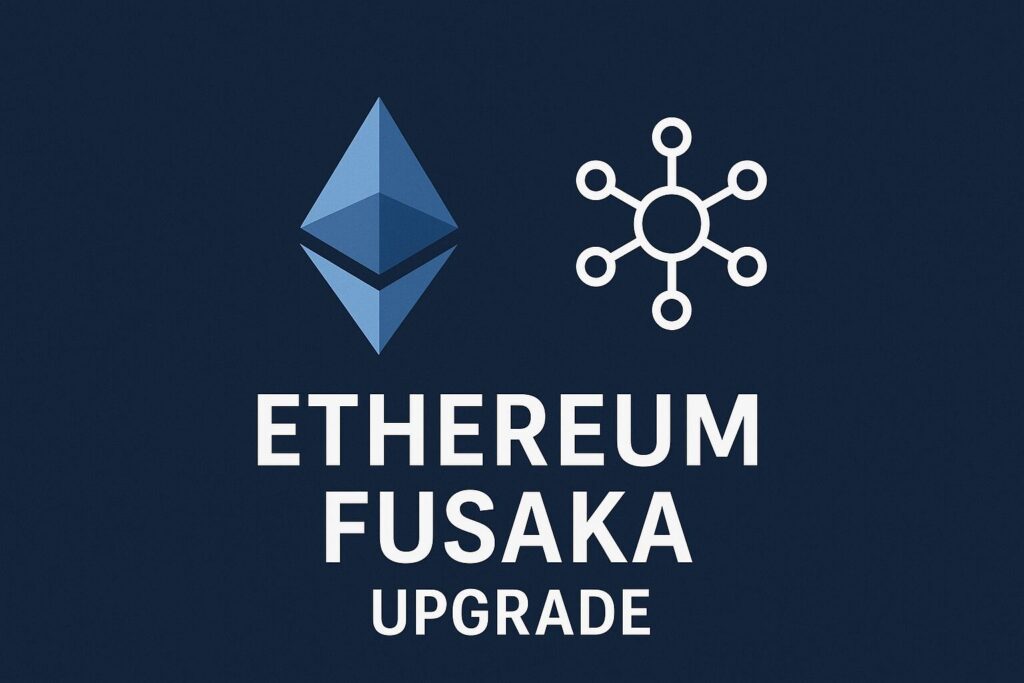
Introduction
The Ethereum Fusaka Upgrade is one of the most anticipated developments in the blockchain space. Scheduled for mainnet activation on December 3, 2025, this upgrade introduces critical scalability and efficiency improvements that will impact both users and developers. By integrating innovations like PeerDAS and gradual blob capacity increases, Ethereum is taking another major step toward mass adoption. In this article, we will explore the technical aspects, on-chain impact, and broader market implications of Fusaka.
What is the Ethereum Fusaka Upgrade?
The Fusaka upgrade is a planned Ethereum network update designed to improve data availability, reduce transaction costs, and enhance overall scalability. It is being tested across multiple testnets—Holesky, Sepolia, and Hoodi—before going live on the Ethereum mainnet.
Key Milestones
| Stage | Network/Testnet | Date |
|---|---|---|
| Initial testing | Holesky | Oct 1, 2025 |
| Next stage | Sepolia | Oct 14, 2025 |
| Final test | Hoodi | Oct 28, 2025 |
| Mainnet launch | Ethereum | Dec 3, 2025 |
| Blob capacity boost (Phase 1) | Mainnet | Dec 17, 2025 |
| Blob capacity boost (Phase 2) | Mainnet | Jan 7, 2026 |
Technical Enhancements in Fusaka
PeerDAS (Peer Data Availability Sampling)
The PeerDAS system allows Ethereum nodes to verify data availability without downloading full blobs. Instead, nodes sample smaller data chunks, which:
- Reduce bandwidth usage
- Lower storage requirements
- Increase efficiency for validators
This ensures Ethereum remains decentralized by making node operation more accessible.
Blob Parameter Upgrades
Ethereum Fusaka Upgrade introduces Blob Parameter Only (BPO) forks that gradually increase blob capacity. This is particularly beneficial for Layer-2 rollups, as they rely heavily on blob storage for data publishing.
Expected benefits include:
- Reduced transaction fees on L2 networks
- Increased throughput and faster confirmations
- Smoother on-chain activity during high demand periods
On-Chain Impact of Fusaka
Transaction Costs
On-chain analysis shows that transaction costs on Ethereum correlate directly with data availability. With expanded blob capacity, L2 solutions like Optimism, Arbitrum, and Base will become more affordable.
- Layer-2 transaction fees could drop by 20-40%
- Mainnet congestion is expected to ease
Scalability and Adoption
By handling more data with less overhead, the Ethereum Fusaka Upgrade strengthens the network’s scalability. This creates opportunities for:
- Institutional adoption
- High-frequency trading apps
- Advanced DeFi ecosystems
Security Considerations
The Ethereum Foundation launched a four-week bug bounty program prior to Fusaka’s release to identify vulnerabilities. This proactive approach enhances security and builds confidence among developers and users.
Market Implications
Short-Term Price Action
Historically, Ethereum upgrades generate speculative interest. Traders anticipate reduced costs and improved efficiency, which may lead to increased demand for ETH.
- Bullish catalysts: Scalability improvements, L2 fee reductions, and ecosystem growth.
- Bearish risks: Technical delays, unforeseen bugs, or underwhelming adoption.
Long-Term Outlook
Fusaka positions Ethereum as a global settlement layer with robust scalability. With expanded blob capacity, Ethereum becomes better equipped to handle mass user adoption and enterprise-level integrations.
Comparison: Fusaka vs Previous Upgrades
| Upgrade | Focus | Impact |
|---|---|---|
| The Merge (2022) | Energy efficiency | Reduced energy by 99% |
| Dencun (2024) | Proto-danksharding | Lowered L2 costs |
| Fusaka (2025) | PeerDAS & Blob capacity | Boosts scalability and throughput |
Challenges & Risks
Despite its potential, the Fusaka upgrade carries certain risks:
- Timeline delays if testnets reveal bugs
- Integration hurdles for Layer-2 projects adjusting to new parameters
- Temporary volatility in gas fees during rollout
However, with thorough testing and phased implementation, Ethereum is mitigating these risks effectively.
Conclusion
The Ethereum Fusaka Upgrade represents a critical step toward solving Ethereum’s scalability challenges. By implementing PeerDAS and increasing blob capacity, the network enhances efficiency, lowers fees, and paves the way for broader adoption. While short-term volatility may occur, the long-term outlook remains strongly positive.
Not financial advice. Always conduct your own research before making investment decisions.





